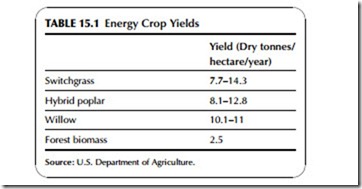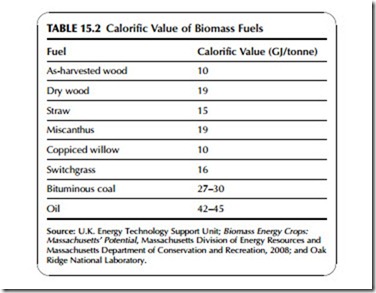FUELWOOD
Fuelwood is the wood that is used for heating and cooking in many parts of the world and that still makes up a significant proportion of primary energy consumption, particularly in poorer areas of the world. Such usage is expected to continue well into the 21st century. In sub-Saharan Africa, for example, these fuels will still account for 42% of primary energy consumption in 2035 accord- ing to the International Energy Agency.
The use of fuelwood is also important in Asia, although consumption in India and China, two major users in the past, is expected to fall over the next two decades. Latin America and the Caribbean also use significant quantities. Many regions also use large quantities of charcoal, which is produced using traditional methods from fuelwood. Total fuelwood consumption was around 18 EJ in 2005 according to the World Energy Council.
In the future some of this wood could be utilized for power generation. The amount that would be available depends on the sustainability of the forests from which it is taken, but it could represent a significant resource for future renewable generation.
ENERGY CROPS
The large-scale development of biomass power generation will depend on a supply of fuel from energy crops. Wastes from the sources outlined above can only provide fuel for a limited generating capacity. Large-scale bioenergy farming is already carried out for the production of biofuels; sugarcane is produced in Brazil and maize in the United States, both for ethanol production, while oil-seed crops are grown in Europe and palm oil in the tropics, both of which provide oils. These liquid fuels are primarily used for transportation applications with ethanol added to gasoline and bio-oils used as diesel substitutes. Crops of a different sort are required for power generation. Such crops are being grown on a small scale in some parts of Europe and the United States, but if a significant industry is to be developed, then much larger areas of land will need to be devoted to such production.
An energy crop that is suitable for a power plant fuel must be fast growing, provide a high annual yield, and be relatively easy to harvest. A number of species have been tested and two groups appear to show the most promise for this purpose: fast-growing trees and grasses. Both of these can be grown relatively easily with minimal use of fertilizers, which are expensive, and both demand relatively little management once established.
Among the tree species that appear to show promise are several species that have traditionally been coppiced as a source of fuel domestic. Willows and poplars thrive in Europe, Scandinavia, and parts of the United States and Canada, and both species can be coppiced.
Coppicing is still the preferred means of harvesting these trees as power plant fuel. Once plantations are established, the growth is cut to the ground every three to five years leaving a stump from which new growth will appear. In warmer, more southerly climates other species such as sweetgum, cotton- wood, sycamore, and eucalyptus have also shown promise. Some of these must be harvested using more traditional wood-cutting techniques.
Since wood from a single plantation cannot be harvested every year, a crop industry will require plantations that can be harvested in rotation so that fuel is available all the time. Typical yields from wood plantations are 10–11 dry tonnes/ha/y for willow and 8–13 dry tonnes/ha/y for poplar as shown in Table 15.1. This compares with a yield of 2.5 dry tonnes/ha/y for forest biomass.
Wood harvesting requires specialist equipment and new types of machinery are being developed for the purpose. Wood, when harvested, contains around 50% moisture and should be dried before combustion to offer the best energy
content. Once dried, wood can be burned directly without need for processing other than sawing. However, wood is sometimes ground to sawdust and formed into pellets using a binder. The resulting fuel is more expensive than untreated wood but does offer a standard product for combustion.
Grasses grow rapidly each year, providing an abundant supply of biomass that can be harvested annually in the autumn when the stalks are virtually dry. Under these conditions the water content of grasses is around 15%, much lower than for freshly harvested woods. Grasses that show promise as crops include switchgrass and miscanthus. The grasses will grow in a variety of habitats but are best suited to natural grasslands such as the U.S. prairies or grassy regions in other parts of the world. Annual yields for switchgrass are 8–14 dry tonnes/ha, as shown in Table 15.1.
The harvesting of grasses is more straightforward than for wood and can be carried out with harvesters and balers similar to those used for cereals. The energy density of loose grass is much lower than wood, so grass is generally formed into briquettes or pellets before transportation. In this form, grass will have around 95% of the energy density of wood.
Table 15.2 shows figures for the calorific value of a range of biomass fuels.
As-harvested wood contains around 10 GJ/tonne, rising to 19 GJ/tonne once it has been dried. Cereal straw contains 15 GJ/tonne, while the energy content of switchgrass is 16 GJ/tonne and for miscanthus it is 16 GJ/tonne. Undried, coppiced willow has an energy content of 10 GJ/tonne typical of an undried wood. In comparison, bituminous coal generally contains 27–30 GJ/tonne and oil 42–45 GJ/tonne.
The combustion of grasses normally produces more ash than the combustion of wood. Against this, the content of trace elements such as chlorine, nitrogen, potassium, and sulfur are often lower, making emission control simpler.
Growing and harvesting a biomass combustion fuel is only the first stage of complex infrastructure that will be required to support the long-term and large-scale development of biomass for power generation. Since harvesting will often be seasonal, fuel must be stored to provide a year-round supply and
transportation networks need to be established to keep power plants supplied. This will require extensive integration of the agriculture and energy industries.
The key issue to be solved, if development is to proceed, is how much land can be put aside for fuel production and how much must be retained for food production. Difficulties are already arising in the tropics where rain forests are being destroyed to make room for palm oil plantations. Balancing the two will be difficult, but there does appear to be areas of land not used or not suitable for food production that could provide combustion fuel. These include some northern forest regions.
The areas of land required to supply a biomass power plant are considerable. On the basis that one hectare of land can produce 10–12 tonnes of dry fuel each year, a 10 MW power plant would require around 7000 ha dedicated to supply it with fuel.

